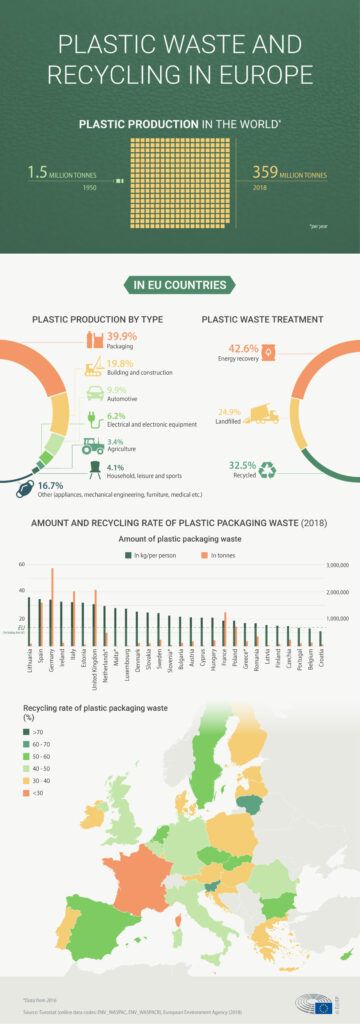Nearly a third of plastic waste in Europe is recycled. Find out more facts and figures on plastic waste and its recycling in the EU with our infographic.
The production of plastic has grown exponentially in just a few decades – from 1.5 million tonnes in 1950 to 359 million tonnes in 2018 worldwide – and with it the amount of plastic waste. After a sharp drop in production in the first half of 2020 due to the Covid-19 pandemic, production recovered again in the second half of the year.
The EU is already taking measures to reduce the amount of plastic waste, but what happens to the waste that is generated despite all efforts? And how can plastic recycling rates be increased?
Plastic waste treatment in Europe
In Europe, energy recovery is the most used way to dispose of plastic waste, followed by recycling. Some 25% of all the generated plastic waste is landfilled.
Half of the plastic collected for recycling is exported to be treated in countries outside the EU. Reasons for export include the lack of capacity, technology or financial resources to treat the waste locally.
Previously, a significant share of the exported plastic waste was shipped to China, but recent restrictions on imports of plastic waste in China is likely to further decrease EU exports. This poses the risk of increased incineration and landfilling of plastic waste in Europe. Meanwhile, the EU is trying to find circular and climate-friendly ways of managing its plastic waste.
The low share of plastic recycling in the EU means significant losses for the economy as well as for the environment. It is estimated that 95% of the value of plastic packaging material is lost to the economy after a short first-use cycle.
Globally, researchers estimate that the production and incineration of plastic pumped more than 850 million tonnes of greenhouse gases into the atmosphere in 2019. By 2050, those emissions could rise to 2.8 billion tonnes, a part of which could be avoided through better recycling.
Read more about waste management in the EU
Problems with plastic recycling
The main issues complicating plastic recycling are the quality and price of the recycled product, compared with their unrecycled counterpart. Plastic processors require large quantities of recycled plastic, manufactured to strictly controlled specifications and at a competitive price.
However, since plastics are easily customised to the needs – functional or esthetic – of each manufacturer, the diversity of the raw material complicates the recycling process, making it costly and affecting the quality of the end product. As a consequence, the demand for recycled plastics is growing rapidly, though in 2018 it accounted for only 6% of plastics demand in Europe.
Find out more about EU plans to reach a circular economy by 2050, including plastic reduction
EU solutions to increase recycling rates
In May 2018, the European Commission put forward a proposal to address the issue of plastic marine litter. It includes an EU ban on the production of the top 10 single-use plastics that are found on European beaches from 3 July 2021.
As part of the Green Deal, 55% of plastic packaging waste should be recycled by 2030. This would imply better design for recyclability, but MEPs believe measures to stimulate the market for recycled plastic are also needed.
These measures could include:
- Creating quality standards for secondary plastics
- Encouraging certification in order to increase the trust of both industry and consumers
- Introducing mandatory rules on minimum recycled content in certain products
- Encouraging EU countries to consider reducing VAT on recycled products
The European Parliament also backed the restriction of light-weight plastic bags in the EU in 2015.
In addition MEPs called on the Commission to take action against micro plastics.







Leave a Reply